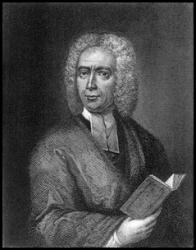- |
User Links
He is Risen: He is not here

Blest morning! whose first dawning rays
Author: Isaac WattsPublished in 154 hymnals
Printable scores: PDF, MusicXMLAudio files: MIDI
Representative Text
1 Blest morning! whose first dawning rays
beheld the Son of God
arise triumphant from the grave,
and leave his dark abode.
2 Wrapt in the silence of the tomb
the great Redeemer lay,
till the revolving skies had brought
the third, th' appointed day.
3 Hell and the grave combin'd their force
to hold our Lord in vain;
sudden the Conqueror arose,
and burst their feeble chain.
4 To thy great name, Almighty Lord!
we sacred honours pay,
and loud hosannahs shall proclaim
the triumphs of the day.
5 Salvation and immortal praise
to our victorious King!
Let heav'n and earth, and rocks and seas,
with glad hosannahs ring.
6 To Father, Son, and Holy Ghost,
the God whom we adore,
be glory, as it was, and is,
and shall be evermore.
Source: The Irish Presbyterian Hymnbook #H4
Author: Isaac Watts
 Isaac Watts was the son of a schoolmaster, and was born in Southampton, July 17, 1674. He is said to have shown remarkable precocity in childhood, beginning the study of Latin, in his fourth year, and writing respectable verses at the age of seven. At the age of sixteen, he went to London to study in the Academy of the Rev. Thomas Rowe, an Independent minister. In 1698, he became assistant minister of the Independent Church, Berry St., London. In 1702, he became pastor. In 1712, he accepted an invitation to visit Sir Thomas Abney, at his residence of Abney Park, and at Sir Thomas' pressing request, made it his home for the remainder of his life. It was a residence most favourable for his health, and for the prosecution of his literary… Go to person page >
Isaac Watts was the son of a schoolmaster, and was born in Southampton, July 17, 1674. He is said to have shown remarkable precocity in childhood, beginning the study of Latin, in his fourth year, and writing respectable verses at the age of seven. At the age of sixteen, he went to London to study in the Academy of the Rev. Thomas Rowe, an Independent minister. In 1698, he became assistant minister of the Independent Church, Berry St., London. In 1702, he became pastor. In 1712, he accepted an invitation to visit Sir Thomas Abney, at his residence of Abney Park, and at Sir Thomas' pressing request, made it his home for the remainder of his life. It was a residence most favourable for his health, and for the prosecution of his literary… Go to person page >Text Information
| First Line: | Blest morning! whose first dawning rays |
| Title: | He is Risen: He is not here |
| Author: | Isaac Watts |
| Meter: | 8.6.8.6 |
| Language: | English |
| Copyright: | Public Domain |
Bless'd morning! whose young, dawning rays. I. Watts. [Sunday—Easter.] Appeared in his Hymns, &c, 1707 (1709, Book ii., No. 72), in 5 stanzas of 4 lines, and entitled, "The Lord's Day: or, The Resurrection of Christ." The arrangements of this hymn in common use are:—
(1.) The original. Very limited.
(2.) "Blessed morning” &c, as in Dr. Hatfield's American Church Hymn Book, N. Y., 1872, with the change in stanza i., line 4, of "last abode," to "dark abode."
(3.) "Blest morning," &c. This opening, sometimes followed by two or three slight alterations and the omission of stanza v., is the most popular form of the text both in Great Britain and America.
(4.) "Blest morning," &c, in the Hymnary, 1872, No. 13. This is very considerably altered.
In addition to these, in 1781, this hymn was added with alterations, as "Hymn IV.," to the Scottish Translations & Paraphrases. It opens "Blest morning ! Whose first dawning rays." The author of this recast is unknown.
-- John Julian, Dictionary of Hymnology (1907)
Notes
Bless'd morning! whose young, dawning rays. I. Watts. [Sunday—Easter.] Appeared in his Hymns, &c, 1707 (1709, Book ii., No. 72), in 5 stanzas of 4 lines, and entitled, "The Lord's Day: or, The Resurrection of Christ." The arrangements of this hymn in common use are:—
(1.) The original. Very limited.
(2.) "Blessed morning” &c, as in Dr. Hatfield's American Church Hymn Book, N. Y., 1872, with the change in stanza i., line 4, of "last abode," to "dark abode."
(3.) "Blest morning," &c. This opening, sometimes followed by two or three slight alterations and the omission of stanza v., is the most popular form of the text both in Great Britain and America.
(4.) "Blest morning," &c, in the Hymnary, 1872, No. 13. This is very considerably altered.
In addition to these, in 1781, this hymn was added with alterations, as "Hymn IV.," to the Scottish Translations & Paraphrases. It opens "Blest morning ! Whose first dawning rays." The author of this recast is unknown.
-- John Julian, Dictionary of Hymnology (1907)


 My Starred Hymns
My Starred Hymns




